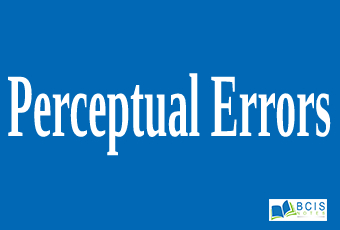
Perceptual errors:
Perceptual errors are called when folks generally use several shortcuts when they judge others. They have frequently used shortcuts in judging others. They are:
- Selective perception: Since we cannot observe everything going on about us, we engage in selective perception.
- Halo effect: refers to the tendency of judging the person entirely based on a single trait that may be favorable or unfavorable.
- Stereotyping: Generalizing or grouping
- Contrast effect: We don’t evaluate a person in an isolation. Contrast error occurs when we evaluate characteristics of a person with other people, it happens all the time in a job interview.
- Projection: refers to the tendency of people to see their own traits in other people. As the saying goes, ‘to an honest man, everybody is honest’ and vice versa.
- Impression: ‘the first impression is the last impression’. This may sometimes lead to perceptual distortion like first bench students are disciplined and intelligent, and last bench students are undisciplined and weak.
OR
The perceptual process may result in a person making errors in judgment or understanding of another person. The most common types of perceptual errors are:
- Accuracy in judgment
- Perceptual defense
- Stereotyping
- The halo effect
- Projection
- Role of culture
- Horn Effect
- Recency effect
- Self Serving Biasness
- Self Fulfilling Prophecy
Accuracy in judgment
- Similarity error – assuming that people who are similar to us ( in terms of background, interests, and hobbies) will behave like us.
- Contrast error – comparing people to others rather than to some absolute standard.
- Overweighting of negative information – a tendency to overreact to something negative.
- Race, age, and gender bias – tendency to be more or less positive based on one’s race, age, or sex.
- First-impression error – forming first impressions that are resistant to change.
Perceptual defense
The tendency for people to protect themselves against ideas, objects, or situations that are threatening.
Stereotyping
The belief that all members of a specific group share similar traits and behaviors.
Halo effect
A tendency to color everything we know about a person because of one recognizable favorable or unfavorable trait.
Projection
is the tendency to see one’s traits in others. The role of culture: Culture influence our perception in selecting information and exhibiting a behavioral pattern in situations
Recency Effect
When the most recent information influences our judgment, even though we have a whole of other information on the person.
Horn Effect
Based on one Negative quality, we assumed the person is BAD i.e. we perceived the whole person, based on ONE quality.
Self-serving Bias
- It is the tendency of attributing own success to internal causes while failure to external causes.
- It represents one’s tendency to take more personal responsibility for success rather than for failure.
- This business tends to increase as time passes after an event.
Ex- Rishi gets the best journalist award in Nepal but fails to get selected as the top 1000 journalist in South Asia. He attributes his success as his ability and his failure as a lack of capability of the judge to determine his ability.
Self-fulfilling prophecy:
People’s preconceived expectations and beliefs determine their behavior, thus, serving to make their expectations come true. E.g. Negative expectations= Negative result
You may also like Learning.
If you liked our content HTML Editor, then Please don’t forget to connect with us through our social media sites. Facebook: Bcis Notes, Instagram: @bcisnotes, and Twitter:@bcisnotes.

Leave a Reply